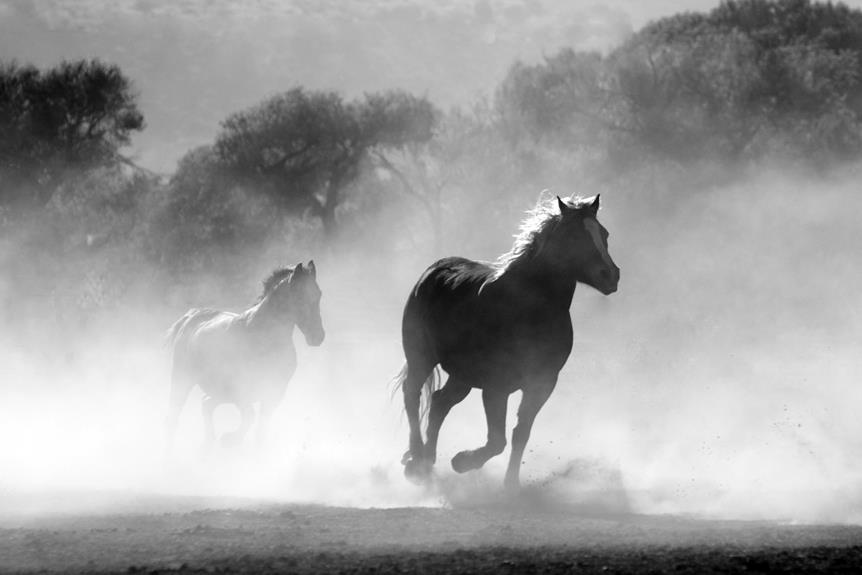Have you ever stood in a meadow, surrounded by a sea of golden waves gently swaying in the breeze? Picture that moment, but instead of grass, imagine it's timothy hay. Timothy hay, with its vibrant green hues, resembles a lush oasis in a desert of brown and beige.
But what exactly does it look like up close? How does it feel in your hands? And what sets it apart from other types of hay?
In this discussion, we will unravel the mysteries of timothy hay, exploring its color, texture, smell, size, shape, and unique characteristics that make it a staple in the equine world.
So, let's embark on this hay-filled journey together and discover the true essence of timothy hay.
Key Takeaways
- Timothy hay can range in color from light to medium green, with hints of yellow or brown, and variations in color can occur due to the presence of other grasses and seed heads.
- The texture of timothy hay is soft and fine, making it easy for animals to chew and digest, and it provides necessary fiber for their diets.
- Timothy hay has a fresh, grassy aroma that is described as sweet, earthy, and inviting, making it a pleasant choice for indoor use.
- Timothy hay is long, thin, and cylindrical in shape, with a consistent and easy-to-handle structure. It is favored by small animals like rabbits, guinea pigs, and chinchillas, and it is distinguishable from other types of hay due to its soft texture and suitability for animals with sensitive digestion.
Color of Timothy Hay
The color of Timothy Hay can range from light to medium green, with hints of yellow or brown depending on weather and growing conditions. This versatile grass is commonly used as feed for small pets like rabbits, guinea pigs, and chinchillas. When Timothy Hay is cut, it often includes other grasses such as orchard grass, which can contribute to variations in color. Additionally, the presence of seed heads in Timothy Hay can add a touch of brown to the overall appearance.
The first cut of Timothy Hay is typically slightly darker in color compared to the second and third cuts. It's important to note that the color of Timothy Hay can also be affected by the drying process. When dried properly, it retains its green color; however, improper drying techniques may result in a more faded or brownish appearance. Some Timothy Hay blends may also contain a mixture of hay and alfalfa, which can affect the color as well.
Texture of Timothy Hay
After exploring the color variations of Timothy Hay, let's now shift our focus to its soft and fine texture that animals find appealing.
Timothy hay, made from the cut heads of Timothy Grass, has a unique texture that small animals love. When you hold a strand of timothy hay in your hand, you can feel its softness and fineness. It isn't rough like other types of hay, making it easy for animals to chew and digest.
The texture of timothy hay is one of its most important qualities. It's known for its long strands of grass that are carefully dried and preserved. The fine texture of timothy hay makes it palatable and enjoyable for animals to eat. Whether it's a rabbit, guinea pig, or chinchilla, they all appreciate the softness of timothy hay in their mouths.
Furthermore, the long strands of timothy hay provide animals with the necessary fiber for their diets. It helps keep their digestive system healthy and promotes regular bowel movements. The texture of timothy hay ensures that animals can easily consume and process this high-quality roughage.
Smell of Timothy Hay
Take a deep breath and prepare to be captivated by the delightful scent of timothy hay. When it comes to the smell of timothy hay, you're in for a pleasant surprise. It has a fresh, grassy aroma that's appealing to both animals and humans alike. The scent of timothy hay is often described as sweet and earthy, with a hint of freshness.
Imagine walking through a field on a sunny day, surrounded by the subtle fragrance of freshly cut grass. That's the essence of timothy hay.
The smell of timothy hay can fill a room with a comforting, hay-like fragrance, evoking a sense of being in a field or barn. It's a nostalgic and inviting scent that can transport you to a simpler time.
What's great about the smell of timothy hay is that it's not overpowering. It has a mild, pleasant odor that won't overwhelm your senses, making it perfect for indoor use.
Size and Shape of Timothy Hay
You'll notice that timothy hay is typically long, thin, and cylindrical in shape. This popular hay is a favorite among small animals like rabbits, guinea pigs, and chinchillas. Its size and shape make it easy for them to nibble on and digest. Let's take a closer look at the size and shape of timothy hay in the table below:
| Type of Hay | Size | Shape |
|---|---|---|
| Timothy Hay | Long | Cylindrical |
| Orchard Grass Hay | Varies | Tapered |
| Grass Hay | Varies | Varies |
As you can see, timothy hay stands out with its long and cylindrical form. Other types of hay, such as orchard grass hay and grass hay, may have varying sizes and shapes. However, pure timothy hay remains a popular choice due to its consistent and easy-to-handle structure. The medium to coarse texture of timothy hay adds to its appeal, providing a slightly rough feel that small animals enjoy munching on. Additionally, the color of timothy hay can range from a light green to a golden yellow, depending on its maturity and drying process. So, whether you're buying hay for your furry friend or simply curious about the different types of hay available, understanding the size and shape of timothy hay can help you make the right choice.
Characteristics That Distinguish Timothy Hay From Other Types of Hay
Timothy hay can be distinguished from other types of hay by its soft, fine texture that's appealing to animals. This type of hay is a popular choice for your small animals because it's high in fiber and low in protein. Compared to other types of hay, such as alfalfa hay or orchard hay, timothy hay provides a higher amount of roughage, making it an excellent choice for animals in need of a high-fiber diet. It's also palatable and easy to digest, making it suitable for animals with sensitive digestion.
One of the key characteristics that sets timothy hay apart is its distinct appearance. It's rare to see pure timothy hay without seed heads, which gives it a unique look. When you see timothy hay, you'll notice that it typically grows up to 6 feet tall, providing a substantial amount of forage for your animals.
Frequently Asked Questions
How Do You Identify Timothy Hay?
To identify timothy hay, look for its distinguishing characteristics. Notice its visual cues, such as its soft texture and color. Pay attention to its scent and smell. Be aware of common mistakes and variations.
What Does Good Timothy Hay Look Like?
Identifying good timothy hay is crucial. Look for leafy, green hay with balanced flower heads. It should have a sweet flavor, tender texture, and be rich in vitamins and minerals. Ensure it's fresh and high-quality.
What's the Difference Between Timothy Grass and Timothy Hay?
The difference between timothy grass and timothy hay is that the grass is greener and slightly higher in protein. Hay is more durable when stored correctly. Both have nutritional benefits and are commonly used as feed for animals.
What Is so Special About Timothy Hay?
Timothy hay is special because it offers nutritional benefits for digestive health. With its long fiber strands, low protein content, and suitability for small animals, it is essential for herbivores and commonly used in pet food.
Conclusion
In conclusion, timothy hay is a nutritious and ideal choice for horses due to its high fiber content and easy digestibility. Its soft, fine texture and green color make it visually appealing to horses.
The presence of seed heads is common, but pure timothy hay without seed heads is rare.
Overall, timothy hay provides essential nutrients and roughage for horses, making it a popular choice among horse owners.



0 Comments